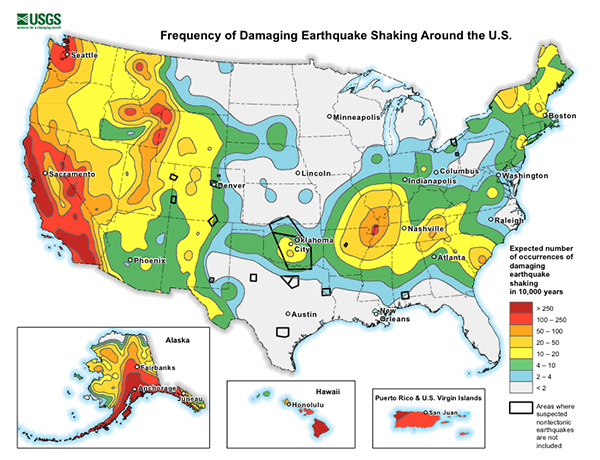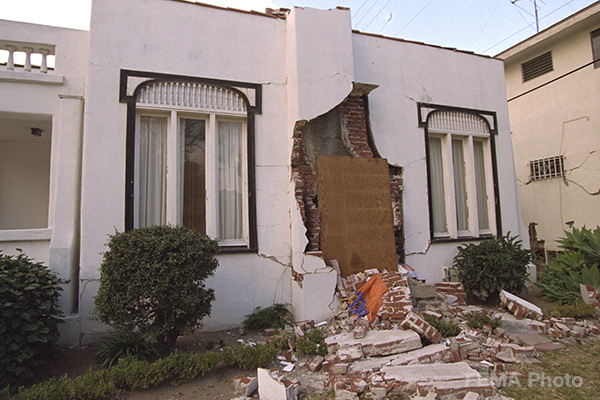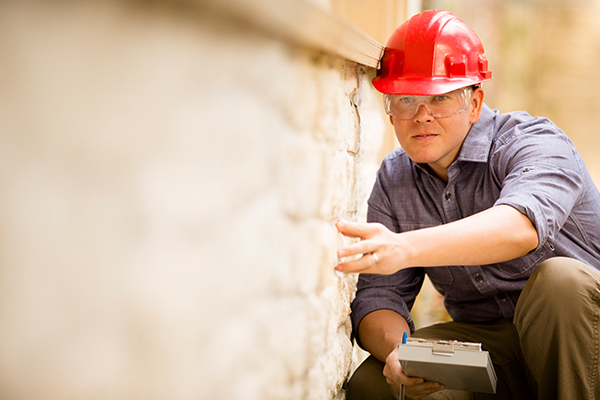Where do most earthquakes occur in the US?
It may come as a big surprise to the 39 million people living in California, but the state of Alaska wins the grand prize when it comes to what state has the most earthquakes. Not only is Alaska the most seismically-active state, it also is where the largest earthquake to ever strike the U.S .occurred—a magnitude 9.2 shaker in 1964.
According to Groundworks, citing data from the United States Geological Survey (USGS), quakes are a fact of life in Alaska. In fact, 11 percent of the world’s earthquakes and 17.5 percent of earthquakes in the United States happen in Alaska, with an average of one magnitude 7.0 to 8.0 shaker per year and a magnitude 8.0 or greater quake happening every 13 years on average.
An active fault, called the Alaskan-Aleutian Megathrust, is a major culprit for Alaska’s seismic activity. Perhaps a saving grace for Alaska is that with a land area of 732,000 square miles and a population of 663,000, fewer people and less built property are in harm’s way, compared to California with its much smaller land area of 163,000 square miles and much larger population of 39 million.
The Golden State of California gets the second place, silver prize when it comes to where most earthquakes occur in the U.S. After Alaska and California, the most earthquake-prone states, according to the World Atlas, are Hawaii placing third, Nevada fourth and Washington state rounding out the top five. Despite their natural beauty, marked by their soaring, majestic mountains, all five of these states in the western part of the country are not without their faults—as in, lots of earthquake faults! As such, our purpose here is to help you have a better understanding of earthquakes, earthquake hazards, your local risks, and the preparedness steps you can take to protect your family and your property.
Top 5 States with the most earthquakes (ranked):
- Alaska
- California
- Hawaii
- Nevada
- Washington State
Why does California have so many earthquakes?
According to the Earthquake Country Alliance, the primary culprit of earthquakes in California is the movement along the San Andreas fault and the many associated faults within the San Andreas Fault System that form the tectonic boundary between the Pacific and North American tectonic plates. The Pacific Plate creeps slowly toward the northwest and is situated beneath a sizable portion of the Pacific Ocean and all of California west of the San Andreas fault. The San Andreas fault is the longest and most well-known fault in California, but it is not the only one that causes earthquakes. Hundreds of other faults are below some of the most densely populated cities in the Golden State. When an earthquake is shallow, a fault rupture may break through the earth’s crust to the earth’s surface. These type quakes can cause damage to roads and buried infrastructure.
In any scientific discussion about what causes earthquakes, you will often hear the terms tectonic plates and plate tectonics used. There is a distinction between the two terms. Tectonic plates are huge slabs of rock that divide the earth’s crust. The tectonic plates are always moving resulting in a reshaping of the earth’s landscape. On the other hand, plate tectonics simply put is a geologic theory, which describes the past and current movement of the earth’s surface.
Another reason that California and Alaska have so many earthquakes is because of their proximity to what USGS earthquake seismologists call the circum-Pacific earthquake belt, which is found along the rim of the Pacific Ocean and is where about 80 percent of the world’s largest earthquakes occur. This earthquake belt also is known as the “Ring of Fire.” The belt is located along boundaries of tectonic plates. Quakes in these zones are caused by slip between plates and rupture within plates. Quakes in this earthquake belt include the magnitude 9.2 Alaska shaker in 1964.
What was the largest earthquake to hit California?
The largest shaker in the history of California was the magnitude 7.9 Fort Tejon earthquake in January of 1857, with the magnitude 7.8 San Francisco quake in April 1906 coming in a close second.
In more recent years, the 1989 6.9 magnitude Loma Prieta earthquake in the Bay Area; the 1994 magnitude 6.7 Northridge earthquake in the San Fernando Valley; the 2014 6.0 magnitude shaker in Napa; and the back-to-back 2019 magnitudes 6.4 and 7.1 Ridgecrest earthquakes in the Mojave Desert stand out.
The costliest of California’s earthquakes was the above-mentioned Northridge earthquake in the early morning hours of January 17, 1994. The magnitude 6.7 shaker, which was followed by two magnitude 6.0 aftershocks, caused about $50 billion in estimated property damage, making it one of the costliest earthquakes in world history, according to the World Atlas. Sadly, the Northridge earthquake also is known for its human toll as 57 people were killed and more than 9,000 injured.
How many earthquakes does California have each year?
An article in National Geographic estimates that every three minutes, an earthquake strikes in California. Citing a study in Science magazine, the National Geographic article said the study reviewed data between 2008 and 2017 and found that Southern California alone experienced 1.81 million shakers during that 10-year period.
While the total number of earthquakes occurring each year in California is significant, the vast majority of the shakers are small and not felt. A relatively small number of between 15 and 20 a year on average exceed a magnitude 4.0, according to the United States Geological Survey (USGS). And, according to USGS earthquake information, Southern California also has the distinction of being where the earliest reported quake occurred in 1769 by a group of explorers in an area about 30 miles southeast of what is now Los Angeles.
What are some major faults in California?
There are literally hundreds of identified earthquake faults running across and through California like arteries in a human body. About 200 of them are considered potentially hazardous based on their slip rates over the last 10,000 years. According to USGS, since the formation of the San Andreas Fault System 25 to 30 million years ago, the juxtaposition of the Pacific and North American tectonic plates are responsible for forming many of those California faults that result in the lateral motion between those plates.
California’s major faults include the San Andreas fault system to the west, the Garlock fault system to the south and the faults of the Sierra Nevada to the east. The San Andreas fault system is the major geologic plate boundary between the North American and Pacific tectonic plates and passes through much of the state. Other major faults are the Hayward fault in the Bay Area and the Rose Canyon fault in San Diego County.
What is California’s earthquake risk?
Living in California where earthquake hazards are numerous, no one gets a pass when it comes to the strong probability of experiencing a natural disaster, such as a major tremblor. There is more than a 99 percent chance of one or more magnitude 6.7 or greater earthquakes occurring over a 30-year period in the Golden State, according to scientists at the USGS.*
It was the 6.7 magnitude Northridge quake that woke up thousands of residents in the San Fernando Valley in the early morning of January 17, 1994. The Northridge quake caused an estimated $50 billion in property damage. Almost five years earlier, on October 17, 1989, the 6.9 magnitude Loma Prieta earthquake rattled the Bay Area, resulting in 63 deaths, more than 3,700 injuries and $6 billion in property damage. More recently, earthquakes of 6.4 magnitude and 7.1 magnitude struck the remote Mojave Desert community of Ridgecrest over the July 4th weekend in 2019, resulting in an estimated $100 million in property damage.
What is your local earthquake risk?
When it comes to the specific, local risk you face from a large earthquake, it depends on where in the state of California you reside. A good way to determine which major earthquake faults are in your area is by going to the USGS's interactive fault map.
Evaluating the earthquake hazards and seismic risks in your area is an important way to be ready when the next major earthquake pays us a visit because it’s not a matter of if, but when, it will occur.
How to keep your family safe during an earthquake
The most important element of earthquake preparedness is taking steps to protect your family, your pets and your home before a major quake occurs. Learn more at our blog on Essential Earthquake Safety Tips at Home.
Learn the Seven Steps to Earthquake Safety
Living in earthquake country, another very important step you can take when it comes to preparedness is to memorize the Seven Earthquake Safety Steps. Particularly important among the “Seven Steps” is the advice to “drop, cover, and hold on” as a quake occurs and to create an accessible earthquake kit containing the essentials you will need in the immediate aftermath of a shaker.
How to protect your home
Even though it is impossible to accurately predict when an earthquake will strike, we still can take measures to mitigate damage and enhance safety by preparing in advance for the next tremblor. These steps include using earthquake straps to secure water heaters and using straps and fasteners to secure appliances and heavy furniture to walls. Learn more about ways to improve your home’s earthquake readiness at the How to Protect Your Home Before an Earthquake blog.
Determine your structural risks
There is no getting around the fact that we live in an earthquake-prone state. While some areas of the state face less of a structural risk than other parts of the state, the level of structural weakness also varies by such things as the type of house, type of foundation and type of construction. The Strengthen Your House page provides more detailed information on how these structural weaknesses can be mitigated by a seismic retrofit.
Consider a seismic retrofit
Simply put, a seismic retrofit is the process of making your home more resistant to the shaking caused by an earthquake. The retrofitting process can be as straightforward as bracing and bolting the frame of your home to the foundation within the crawl space or for homes with a living space over a garage, installing new plywood sheathing and steel columns on each side of the garage door. If you live in California and your house was built before 1980, your dwelling may be particularly at risk of damage to earthquake shaking because it was built before seismic building codes were put in place. Our previous blog, Is Retrofitting Worth It? can help you determine if a seismic retrofit is something you should strongly consider.
Strengthen your home
With home values continuing to rise, many California homeowners have come to realize that the value of their dwelling and the home equity they have accumulated represent the lion’s share of their savings and their retirement account. With the possibility of a major earthquake striking at any moment, a seismic retrofit can also provide peace of mind and assurance that you have taken vitally important steps to protect your family, your pets and your property.
*According to the third Uniform California Earthquake Rupture Forecast (UCERF3) report.




